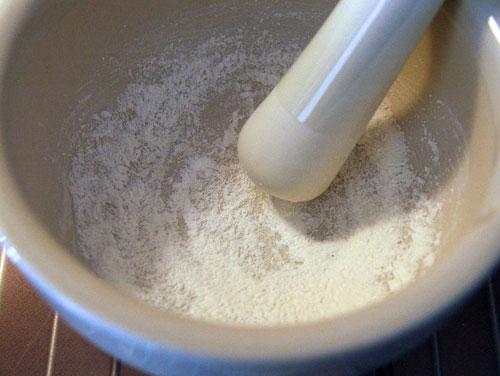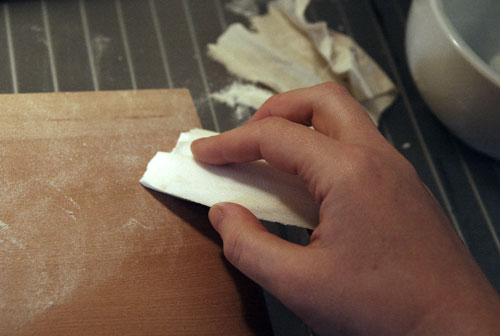Cuttle polishing
Wow, that really works. Cuttlebone is 14th century sandpaper.
I found a cuttlebone at the pet store. I don't know that you can get them anywhere else and though I had a look around the jewelry making supplies at Tokyu Hands, I didn't try anywhere else. 21st century pet parakeets around the world keep the cuttlebone industry alive and well. That's good enough for me.
I also purchased a ceramic mortar and pestle so that I could grind the cuttlebone into powder. As it turns out, that was unnecessary. Jim explained how he used cuttlebone when he did antique paper restoration (I have a friend who has done paper restoration, wow), just peeling off the hard shell and rubbing the softer inside part against the paper.
I decided to try it both ways.

Ground cuttlebone
I broke off a bit of the cuttlebone and crushed it up in the mortar, then ground it for about 5 minutes to produce the powder pictured above. I sprinkled it on the sakura board and rubbed it in with a piece of unbleached muslin. It worked pretty well, especially when I took a teaspoon of the powder, wrapped it in the cloth and used that against the board.

Cuttle polishing directly on the board
But Jim's method worked better and it was easier since I didn't need to grind the cuttle first. After going over it thoroughly with the cuttle and producing a lot of dust, I used my powder-filled cloth to continue the polishing.
I discovered (maybe re-discovered is truer) that I am impatient with the work, so I put on some old pop music and sanded the big board for a full two songs. Then I dusted everything off with a clean rag and went to rinse the boards clean.
Cennino says
...smooth and clean, that is, washed with clear water; rubbed and smoothed down with cuttle such as the goldsmiths use for casting. And when this little panel is thoroughly dry...
I didn't wash the boards first, because I assumed that modern milling and distribution practices are pretty clean and tidy. Tokyu Hands is not full of sawdust. But I should not think I know better than my master. When I washed the boards after polishing, all of them but the walnut raised up their grain and became rough and scratchy. Maybe boxwood would behave differently. Regardless, now they are drying in the chilly, dry winter day. When they are dry, I will polish them again and simply do a very good job of dusting off the excess powder, instead of washing them clean.
I had chicken wings for lunch today just so I could get some bones. Yesterday my friend Maeda-san at Amorosso gave me some lamb rib bones (not the thigh or shoulder bone that Cennino recommends and who knows if the lamb was gelded, but I'll try the ribs and see how they go) Tonight I will fire up the BBQ and toss my chicken and lamb bones into the coals and see if I can get them to turn "whiter than ashes."
Comments
Somewhere, your father is smiling.
Posted by: Fran | January 20, 2007 04:53 AM